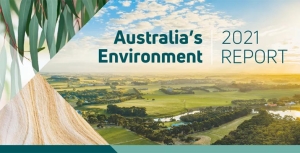Displaying items by tag: State of the Environment Report
State of the Environment 2021 – a shocking report
The first State of the Environment (SoE) report for Australia was produced in 1996 by a team led by Prof Ian Lowe. The latest report was released on 19 July after being sat on by the Morrison government since last December. The lead author this time is Prof Emma Johnson. Both these leading ecologists have presented a lecture to STEP members, Ian Lowe in 2012 and Emma in 2014.
These are important documents. Each state may produce a similar environment report but state boundaries tend to hide data of cumulative effects.
The 2021 report highlights the most important areas where action is urgent. As the new Minister for the Environment and Water, Tania Plibersek stated this ‘shocking report’ told ‘a story of crisis and decline in Australia’s environment, and of a decade of government inaction and wilful ignorance.’ She promised: ‘I won’t be putting my head in the sand … the environment is back on the priority list’.
Some major points to note
More threatened species have been listed and existing populations are becoming more threatened. The number of plant and animal species listed as threatened in June 2021 was 1,918, up from 1,774 in 2016. The previous issue of STEP Matters has a detailed summary of the state of Australia’s biodiversity.
Land clearing – the EPBC Act is totally ineffective. 7.7 million hectares of potential habitat for terrestrial threatened species was cleared between 2000 and 2017 (for context, Tasmania is 6.8 million hectares). Much of the clearing occurred in small increments. Over 93% of land clearing was not referred to the Australian government for assessment, meaning the loss was not scrutinised under the EPBC Act. This highlights cumulative impacts, one of the factors that the Samuel Review called for inclusion in development assessments.
Climate change is exacerbating pressures on every Australian ecosystem. Many Australian ecosystems have evolved to rebound from extreme ‘natural’ events such as bushfires. But the frequency, intensity, and compounding nature of recent events are greater than they’ve experienced throughout their recent evolutionary history. Climate change is compounding ongoing and past stresses from human impact so we have to expect more species extinctions over the next decades.
Inland water and marine environments – our nearshore reefs are in overall poor condition due to poor water quality, invasive species and marine heatwaves. We are all aware of the harm being done to the Great Barrier Reef by bleaching events. Inland water systems, including in the Murray Darling Basin, are under increasing pressure. By the time the Morrison Government left office, they had only delivered two of the promised 450 GL of environmental water and they had no plan to find the extra 448 GL by 2024, when it’s due.
Urban expansion – we’re reducing the quantity and quality of native habitat outside protected areas through, for instance, urban expansion on land and over-harvesting in the sea. However there is no acknowledgement of the need to limit population growth.
Some reasons for optimism
Indigenous knowledge – traditional fire management is being recognised as vital knowledge by land management organisations and government but progress and funding are slow. Work must still be done to empower Indigenous communities and enable Indigenous knowledge systems to improve environmental and social outcomes.
Biodiversity restoration –there are many programs for improving our biodiversity but Australia is increasingly relying on costly ways to conserve biodiversity. This includes restoration of habitat, reintroducing threatened species, translocation (moving a species from a threatened habitat to a safer one), and ex situ conservation (protecting species in a zoo, botanical garden or by preserving genetic material). On the positive side individuals, non-government organisations and businesses are increasingly 7 purchasing and managing significant tracts of land for conservation.
What the new government is doing – in the speech to the National Press Club when she released the SoE report, Environment and Water Minister, Tania Plibersek stated that the update of the EPBC Act is a priority. The response to the Samuel Review will be completed by the end of this year and the government will aim to develop new legislation for 2023. They have promised a new Environmental Protection Agency with power to enforce the legislation.
The Government will set a national goal of protecting 30% of our land and 30% of our oceans by 2030. Only 16% (13 of 84) of Australia’s nationally listed threatened ecological communities meet a 30% minimum protection standard in the national reserve system.
The goal for reduction in greenhouse gas emissions has already been approved. There will also be a review of the carbon offset market that has been roundly criticised – see STEP Matters Issue 215. Conversely coal and gas projects are still being approved.
Decisions need to be built on good data. The government has promised to restore funding for the Environment Department that was cut by 40% by the Morrison government.
NSW State of the Environment report – a mixed result
The EPA released the three-yearly State of the Environment Report (SoE) in February. There are some pluses but mostly it paints a sorry picture. It boils down to the human impact from climate change and population growth.
The Australian SoE was sent to the Minister for the Environment, Susan Ley, in December. But it is has not been made public yet. The minister is required to table the report in parliament within 15 sitting days of receiving it. Parliament has sat only briefly this year so the government is not legally required to release it until the next parliament forms. What is she trying to hide?
For a change the NSW report does acknowledge the significance of population growth ‘population growth is the main driver of environmental issues’.
Yet, the NSW government’s top bureaucrats have urged the premier, Dominic Perrottet, to take a national leadership position and advocate a temporary five-year doubling of the pre-pandemic migration rate, which would increase the NSW population by about 2 million in 5 years. The argument is that this would rebuild the economy and address labour shortages.
The economy seems to be doing all right, thank you! Labour shortages seem to be a perpetual issue despite high immigration for most of this century. Perhaps it is more to do with wages being too low in the affected sectors of the economy. In 2018, Gladys Berejiklian, called for a pause to enable the state’s infrastructure to catch up. This still hasn’t happened.
Some pluses in this SoE report include:
- Air and urban water quality are generally good but the state’s major inland river systems continue to be affected by water extraction, altered river flows, loss of connectivity and catchment changes such as altered land use and vegetation clearing.
- Greenhouse gases are declining having fallen by 17% since 2005. Renewable energy sources have grown but they are still only 19% of electricity power in 2020. But, unlike the federal government, there is actually a plan to get to net zero by 2050.
- About 9.6% of NSW is conserved in the public reserve system. The rate of new reservations has increased markedly, with around 305,000 ha being added to reserves since 2018.
What about biodiversity?
The story on biodiversity is very different. Much loss can be attributed to the Black Summer bushfires but the downward trend has accelerated due to climate change and land clearing.
Improvements have been made through the Saving our Species program. $175 million has been allocated to the program for the 10 years to 2026, and $240 million has been allocated over five years to support a greater commitment to long-term conservation of biodiversity on private land.
Land clearing is the greatest threat to biodiversity. Land clearing and logging of native forests continue at record levels (54,500 hectares in 2019). Unrealistic logging contracts are driving the rates of tree felling which is crazy when several reports have shown that the government is losing money on logging operations. Land clearing is now so bad that in February the koala was declared an endangered species under the Commonwealth EPBC Act.
Money is going into saving species but the amount of land clearing is likely to be creating more threatened species. Invasive species are also a major threat. The regulatory framework under the Biodiversity Conservation Act is failing as was predicted by environment groups and the EDO.


